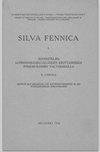Carbon emissions from dryland shifting cultivation: a case study of Mexican tropical dry forest.
IF 1.7
3区 农林科学
Q2 FORESTRY
引用次数: 14
Abstract
The article considers the relation of shifting cultivation to deforestation and degradation, and hence its impacts in terms of carbon emissions and sequestration potential. There is a need to understand these relationships better in the context of international policy on Reduced Emissions from Deforestation and Forest Degradation (REDD+). The article reviews the way in which shifting cultivation has been incorporated in global and national estimations of carbon emissions, and assembles the available information on shifting cultivation in Tropical Dry Forests (TDF) in Mexico, where it is widely practiced. It then takes the case of two villages, Tonaya and El Temazcal, which lie within the basin of the River Ayuquila in Jalisco, Mexico. Field data for the typical carbon stocks and fluxes associated with shifting cultivation are compared with stocks and fluxes associated with more intensive agricultural production in the same dry tropical forest area to highlight the carbon sequestration dynamics associated with the shortening and potential lengthening of the fallow cycles. The biomass density in the shifting cultivation system observed can reach levels similar to that of old growth forests, with old fallows (>20 years) having higher carbon stocks than old growth forests. Per Mg of maize produced, the biomass-related emissions from shifting cultivation in the traditional 12 year cycle are about three times those from permanent cultivation. We did not, however, take into account the additional emissions from inputs that result from the use of fertilizers and pesticides in the case of permanent agriculture. Shortening of the fallow cycle, which is occurring in the study area as a result of government subsidies, results in higher remaining stocks of carbon and lower emissions at the landscape level.旱地轮作产生的碳排放:以墨西哥热带干林为例的研究。
本文考虑了转移耕作与森林砍伐和退化的关系,以及其在碳排放和固存潜力方面的影响。有必要在减少毁林和森林退化造成的排放的国际政策(REDD+)的背景下更好地理解这些关系。本文回顾了将轮作纳入全球和国家碳排放估算的方法,并收集了墨西哥热带干燥森林轮作的现有信息。然后,它以位于墨西哥哈利斯科州阿尤奎拉河流域的两个村庄托纳亚和埃尔特马斯卡尔为例。将与轮作耕作有关的典型碳储量和碳通量的实地数据与同一干旱热带林区与更集约农业生产有关的碳储量和碳通量进行比较,以突出与休耕周期缩短和可能延长有关的碳固存动态。观测到的轮作系统的生物量密度可以达到与原生林相似的水平,其中老林休耕(50 ~ 20年)的碳储量高于原生林。在传统的12年周期内,每生产1毫克玉米,轮作产生的与生物量有关的排放量大约是永久耕作的3倍。然而,我们没有考虑到在永久农业的情况下,由于使用化肥和农药而产生的额外排放。由于政府补贴,研究区休耕周期缩短,导致景观层面的剩余碳储量增加,排放减少。
本文章由计算机程序翻译,如有差异,请以英文原文为准。
求助全文
约1分钟内获得全文
求助全文
来源期刊

Silva Fennica
农林科学-林学
CiteScore
3.50
自引率
11.10%
发文量
21
审稿时长
3 months
期刊介绍:
Silva Fennica publishes significant new knowledge on forest sciences. The scope covers research on forestry and forest ecosystems. Silva Fennica aims to increase understanding on forest ecosystems, and sustainable use and conservation of forest resources. Use of forest resources includes all aspects of forestry containing biomass-based and non-timber products, economic and social factors etc.
 求助内容:
求助内容: 应助结果提醒方式:
应助结果提醒方式:


